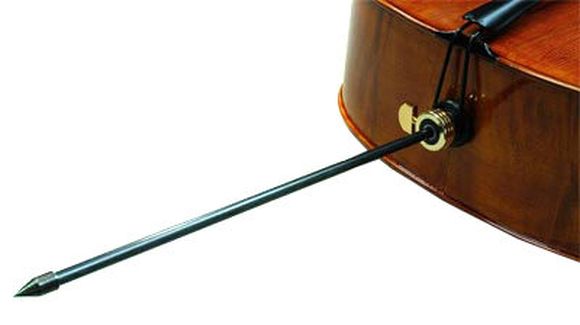3. Materials & Components
Body
The top, or belly is made of spruce, a timber of plain, straight grain, while the ribs and back are invariably made of maple, often spectacularly figured. As it is difficult to find large enough pieces of timber of the required shape and quality, both top and back tend to be constructed of two pieces of wood, seamlessly joined down the middle.
Fingerboard
The only other permanent external fixture is the fingerboard, which is made of ebony. Ebony is an extraordinarily heavy, dense timber - drop a piece into water and it will actually sink. The best ebony, after long seasoning in the sun, is a startling blue-black colour, and is used for the fingerboard because it is one of the few woods hard enough to cope with the wear that this part of the instrument is subjected to. The fingerboards of many cellos unlike those on violins are chamfered back along the length of the C string. This allows extra room for the string to vibrate when playing, something you will find the lower pitched strings do very visibly.
Most of the other parts of the instrument are essentially detachable, though the dismantling of some of them by the novice has the undesirable potential to end in tears! The sort of work that can be undertaken by beginners and students is outlined in the Maintenance & Cleaning section below.
Pegs, Tailpiece & Chin Rest
Ebony is also often used for the pegs, the tailpiece and the endpin. While this can lend a degree of visual co-ordination to the completed instrument, other woods can also be used to great effect. Many cellos have pegs and tailpieces of maple or rosewood (which despite its name, has nothing to do with roses, but much to do with the fact that certain genera have a distinctively sweet smell), while the somewhat politically incorrect ivory makes an occasional appearance on older, grander instruments.
Spike or Endpin
The spike found on all cellos today is a fairly recent design development. Until the early 19th Century, cellists would hold the instrument by supporting the body between the legs though, following its introduction, the spike grew rapidly in popularity as it made playing considerably easier in a number of ways. Obviously it allowed the cello to be kept at a predetermined height, but by connecting the instrument firmly to the floor, it also improved sound projection. Anyone who has spent time in a room with a cellist playing upstairs will be well aware that most floors/ceilings become excellent sounding boards!
Bridge
The bridge has a crucial role to play in what makes a particular cello sound the way it does. Small differences in the thickness, shaping and exact positioning can have dramatic effects on the voicing of an instrument. Unlike the bridges of violins and violas, which sit very close to the body of the instrument, cello bridges are raised up on what amount to a built-in pair of legs. All bridges are made of a specific type of maple and cut from the timber in a particular way, its design - like many of the more apparently decorative parts of stringed instruments - is the result of years of trial and error on the part of makers, and is largely functional.
Soundpost
Like the bridge, the soundpost needs to be positioned with great care to ensure the instrument sounds its best a job that should be done by an expert using a special tool designed for the purpose. The tiniest adjustments to its placing have a major effect on the way the instrument speaks and the balance of the four strings. Very roughly, it stands close to the right foot of the bridge to share the tension of the strings between the back and belly of the instrument, and to stop the bridge from crashing through! Remember, if you completely slacken or remove all four strings at the same time, it is very likely (without the considerable pressure of the bridge bearing down on it) that the sound post will fall over. Should this happen, do not, under any circumstances re-tighten the strings the potential consequences are obvious and repair will be expensive! Instead, take the instrument to a repairer to have the soundpost re-fitted - a very much cheaper alternative. The situation is best avoided in the first place by making sure that at least two strings remain taught at all times.







